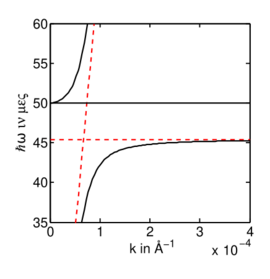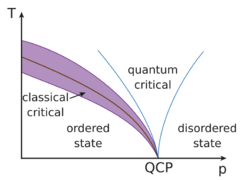Physics:Polariton
This article may be too technical for most readers to understand. Please help improve it to make it understandable to non-experts, without removing the technical details. (April 2018) (Learn how and when to remove this template message) |

In physics, polaritons /pəˈlærɪtɒnz, poʊ-/[1] are quasiparticles resulting from strong coupling of electromagnetic waves with an electric or magnetic dipole-carrying excitation.[example needed] They are an expression of the common quantum phenomenon known as level repulsion, also known as the avoided crossing principle. Polaritons describe the crossing of the dispersion of light with any interacting resonance. To this extent polaritons can also be thought of as the new normal modes of a given material or structure arising from the strong coupling of the bare modes, which are the photon and the dipolar oscillation. The polariton is a bosonic quasiparticle, and should not be confused with the polaron (a fermionic quasiparticle), which is an electron plus an attached phonon cloud.
Whenever the polariton picture is valid (i.e., when the weak coupling limit is an invalid approximation), the model of photons propagating freely in crystals is insufficient. A major feature of polaritons is a strong dependency of the propagation speed of light through the crystal on the frequency of the photon. For exciton-polaritons, a wealth of experimental results on various aspects have been gained in the case of copper(I) oxide.
History
Oscillations in ionized gases were observed by Lewi Tonks and Irving Langmuir in 1929.[2] Polaritons were first considered theoretically by Kirill Borisovich Tolpygo.[3][4] They were termed light-excitons in Soviet scientific literature. That name was suggested by Solomon Isaakovich Pekar, but the term polariton, proposed by John Hopfield, was adopted. Coupled states of electromagnetic waves and phonons in ionic crystals and their dispersion relation, now known as phonon polaritons, were obtained by Tolpygo in 1950[3][4] and, independently, by Huang Kun in 1951.[5][6] Collective interactions were published by David Pines and David Bohm in 1952, and plasmons were described in silver by Herbert Fröhlich and H. Pelzer in 1955. R.H Ritchie predicted surface plasmons in 1957, then Ritchie and H.B. Eldridge published experiments and predictions of emitted photons from irradiated metal foils in 1962. Otto first published on surface plasmon-polaritons in 1968.[7] Room-temperature superfluidity of polaritons was observed[8] in 2016 by Giovanni Lerario et al., at CNR NANOTEC Institute of Nanotechnology, using an organic microcavity supporting stable Frenkel exciton-polaritons at room temperature. In February 2018, scientists reported the discovery of a new three-photon form of light, which may involve polaritons, that could be useful in the development of quantum computers.[9][10]
Types
A polariton is the result of the combination of a photon with a polar excitation in a material. The following are types of polaritons:
- Phonon polaritons result from coupling of an infrared photon with an optical phonon;
- Exciton polaritons result from coupling of visible light with an exciton;[11]
- Intersubband polaritons result from coupling of an infrared or terahertz photon with an intersubband excitation;
- Surface plasmon polaritons result from coupling of surface plasmons with light (the wavelength depends on the substance and its geometry);
- Bragg polaritons ("Braggoritons") result from coupling of Bragg photon modes with bulk excitons;[12]
- Plexcitons result from coupling plasmons with excitons;[13]
- Magnon polaritons result from coupling of magnon with light;
- pi-tons result from coupling of alternating charge or spin fluctuations with light, distinctly different from magnon or exciton polaritons;[14]
- Cavity polaritons.[15]
See also
References
- ↑ "Polariton". Polariton. Oxford University Press. http://www.lexico.com/definition/Polariton.
- ↑ Tonks, Lewi; Langmuir, Irving (1929-02-01). "Oscillations in Ionized Gases". Physical Review 33 (2): 195–210. doi:10.1103/PhysRev.33.195. Bibcode: 1929PhRv...33..195T.
- ↑ Jump up to: 3.0 3.1 Tolpygo, K.B. (1950). "Physical properties of a rock salt lattice made up of deformable ions". Zhurnal Eksperimentalnoi I Teoreticheskoi Fiziki (J. Exp. Theor. Phys.) 20 (6): 497–509, in Russian.
- ↑ Jump up to: 4.0 4.1 K.B. Tolpygo, "Physical properties of a rock salt lattice made up of deformable ions", Zh. Eks.Teor. Fiz. vol. 20, No. 6, pp. 497–509 (1950), English translation: Ukrainian Journal of Physics, vol. 53, special issue (2008); "Archived copy". http://ujp.bitp.kiev.ua/files/journals/53/si/53SI21p.pdf.
- ↑ Huang, Kun (1951). "Lattice vibrations and optical waves in ionic crystals". Nature 167 (4254): 779–780. doi:10.1038/167779b0. Bibcode: 1951Natur.167..779H.
- ↑ Huang, Kun (1951). "On the interaction between the radiation field and ionic crystals". Proceedings of the Royal Society of London. A 208 (1094): 352–365. doi:10.1098/rspa.1951.0166. Bibcode: 1951RSPSA.208..352H.
- ↑ Otto, A. (1968). "Excitation of nonradiative surface plasma waves in silver by the method of frustrated total reflection". Z. Phys. 216 (4): 398–410. doi:10.1007/BF01391532. Bibcode: 1968ZPhy..216..398O.
- ↑ Lerario, Giovanni; Fieramosca, Antonio; Barachati, Fábio; Ballarini, Dario; Daskalakis, Konstantinos S.; Dominici, Lorenzo; De Giorgi, Milena; Maier, Stefan A. et al. (2017). "Room-temperature superfluidity in a polariton condensate". Nature Physics 13 (9): 837–841. doi:10.1038/nphys4147. Bibcode: 2017NatPh..13..837L.
- ↑ Hignett, Katherine (16 February 2018). "Physics Creates New Form Of Light That Could Drive The Quantum Computing Revolution". Newsweek. http://www.newsweek.com/photons-light-physics-808862.
- ↑ Liang, Qi-Yu (16 February 2018). "Observation of three-photon bound states in a quantum nonlinear medium". Science 359 (6377): 783–786. doi:10.1126/science.aao7293. PMID 29449489. Bibcode: 2018Sci...359..783L.
- ↑ Fox, Mark (2010). Optical Properties of Solids (2 ed.). Oxford University Press. p. 107. ISBN 978-0199573370. https://global.oup.com/academic/product/optical-properties-of-solids-9780199573370?lang=en&cc=no.
- ↑ Eradat, N. (2002). "Evidence for braggoriton excitations in opal photonic crystals infiltrated with highly polarizable dyes". Appl. Phys. Lett. 80 (19): 3491. doi:10.1063/1.1479197. Bibcode: 2002ApPhL..80.3491E.
- ↑ Yuen-Zhou, Joel; Saikin, Semion K.; Zhu, Tony; Onbasli, Mehmet C.; Ross, Caroline A.; Bulovic, Vladimir; Baldo, Marc A. (2016-06-09). "Plexciton Dirac points and topological modes" (in en). Nature Communications 7: 11783. doi:10.1038/ncomms11783. ISSN 2041-1723. PMID 27278258. Bibcode: 2016NatCo...711783Y.
- ↑ Kauch, A. (2020). "Generic Optical Excitations of Correlated Systems: pi-tons". Phys. Rev. Lett. 124 (4): 047401. doi:10.1103/PhysRevLett.124.047401. PMID 32058776. Bibcode: 2020PhRvL.124d7401K.
- ↑ Klingshirn, Claus F. (2012-07-06). Semiconductor Optics (4 ed.). Springer. p. 105. ISBN 978-364228362-8. https://www.springer.com/us/book/9783642283611.
Further reading
- Baker-Jarvis, J. (2012). "The Interaction of Radio-Frequency Fields With Dielectric Materials at Macroscopic to Mesoscopic Scales". Journal of Research of the National Institute of Standards and Technology (National Institute of Science and Technology) 117: 1–60. doi:10.6028/jres.117.001. PMID 26900513.
- Fano, U. (1956). "Atomic Theory of Electromagnetic Interactions in Dense Materials". Physical Review 103 (5): 1202–1218. doi:10.1103/PhysRev.103.1202. Bibcode: 1956PhRv..103.1202F.
- Hopfield, J. J. (1958). "Theory of the Contribution of Excitons to the Complex Dielectric Constant of Crystals". Physical Review 112 (5): 1555–1567. doi:10.1103/PhysRev.112.1555. Bibcode: 1958PhRv..112.1555H.
- "New type of supercomputer could be based on 'magic dust' combination of light and matter" (in en). University of Cambridge. 25 September 2017. http://www.cam.ac.uk/research/news/new-type-of-supercomputer-could-be-based-on-magic-dust-combination-of-light-and-matter.
External links
- YouTube animation explaining what is polariton in a semiconductor micro-resonator.
- Description of the experimental research on polariton fluids at the Institute of Nanotechnologies.
 |


